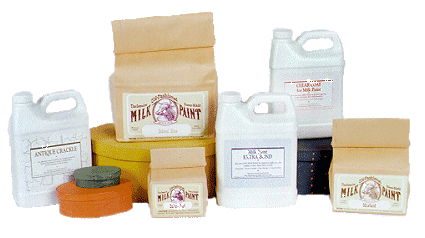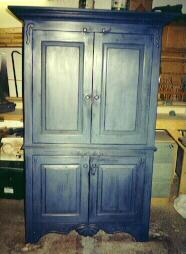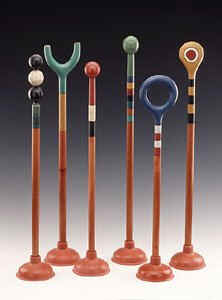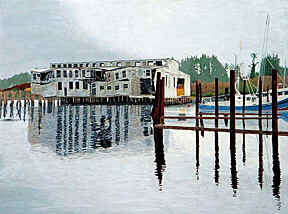
If you’ve ever stripped paint off an old piece of furniture, you may have come across a coat of paint (usually the last layer after the relative ease of latex and lead paint) that seemed to defy even the most caustic stripper. It was probably milk paint! Often homemade, its heyday was the colonial period in America, but it’s been found in Egyptian tombs and even cave paintings. By the 20th century, however, milk paint had all but disappeared.![]()
And that’s what Charles Thibeau discovered 30 years ago. He was making reproduction period furniture in Groton, Massachusetts, and wanted his pieces to have an authentic milk paint finish. He scoured the libraries in Boston and at MIT for formulas.
“There were tons of old recipes,” explained Anne Thibeau, Charles daughter. “Some were better than others, and he just started experimenting. I think he probably conducted about 200 experiments until he came up with a formula that had just the ‘look’ he was after.”
If you haven’t seen it, Anne described that look as a very chalky, flat, matte finish that’s unmatchable with modern paint. And around the same time Charles perfected the look, Yankee Magazine was producing a series of books on forgotten arts. They wanted to incorporate an article on paint made from scratch and included an interview with Charles in the book.

“After the article appeared,” Anne recalled, “our phone started ringing off the hook with people looking for this paint. It was mostly people who were restoring houses, furniture, making reproductions & people like my father who were trying to restore finishes.”
Prior to developing milk paint, Charles worked in the printed circuit industry, owned a nightclub in Boston, studied to be a gemologist (and still works in that field from time to time), and was involved in establishing the first Earth Day in Boston. But antiques and furniture making had been his hobby since he was a kid. And when he realized how big the milk paint market could be, Charles decided to make a business out of it.

Starting out as a niche product for restoration and reproduction, The Old Fashioned Milk Paint Company’s steady growth over the next 30 years has as much to do with its natural ingredients as its authentic finish.
“It’s an all-natural paint and completely nontoxic,” Anne noted, “with no petrochemicals, no fumes. It’s the same environmentally friendly materials that have been used forever & just the right combination of casein. Milk protein is the binder that makes it stick, and we use lime, clays, and earth pigments such as ochre, umber, iron oxide, and lampblack for color.”
“We have 16 rather deep, rich, historic colors. People can mix and match them to create an infinite number of other colors. If anyone wants a fire engine or cherry red, however, they are not going to get that with our paint. Our red iron oxide is a very earthy red. But we offer a base with no pigment for people who want to add their tinting color or any water-soluble pigments.”
According to Anne, a milk paint finish can be streaky and uneven looking, but that’s what most people love about it. Despite the fact it gets harder and harder over time (and eventually almost impossible to remove), it does not have any sealing qualities of its own and requires a durable sealer, especially in the kitchen.
Like several other artists, Maine artist Dominic White uses Milk Paint in his paintings. According to Anne, “They just can’t get the results with other types of paints.” Competitors have appeared periodically over the years. There are lots of recipes and anyone can make it. But most competitors don’t last and some, as Anne described, sold a liquid that was really just simulated milk paint colors, usually in latex or oil. Her company’s product comes in powder form, so it does not have any preservatives in it.

“The milk is already in it and you just add water. It is just like making chocolate milk,” Anne explained.
The company has a half dozen employees today, and Anne doesn’t see it becoming much larger in the near future. That may change. Her father recently came back out of retirement and has taken on the marketing aspects & determined to bring the company and milk paint into the new century.
Milk paint is available through a network of 400 dealers across the country or directly from the company’s Web site.







